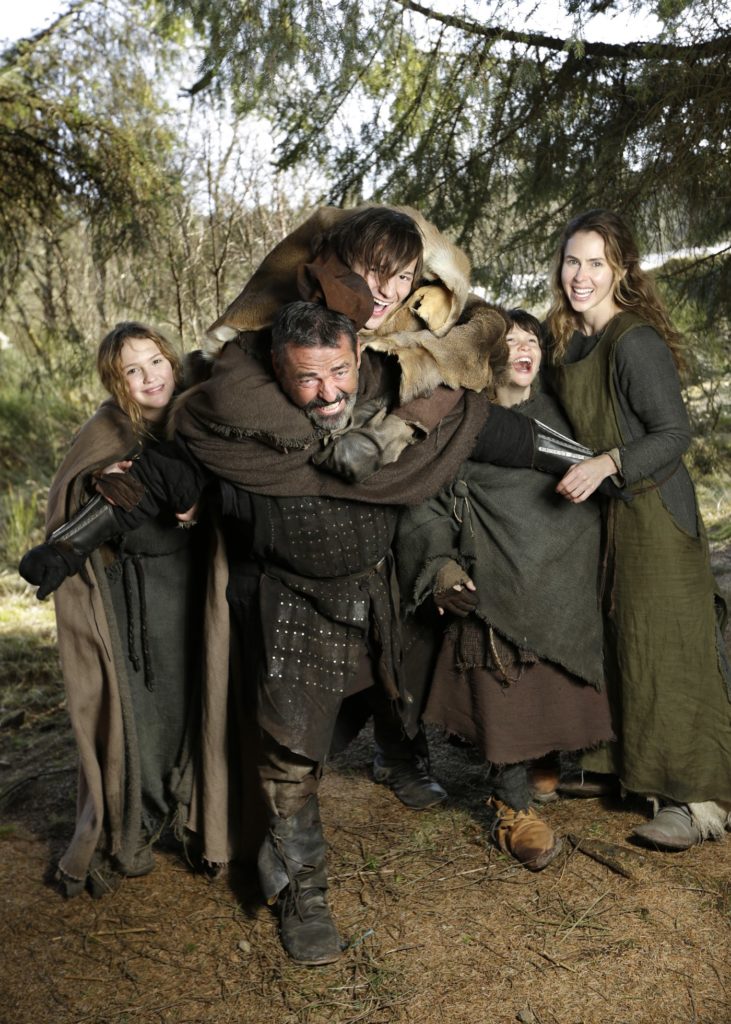
Robert the Bruce
This is not the story of a man who has been defeated in war coming back with a sword in his hand. This is the story of a family broken apart by war coming together with love in its heart.
This beautifully woven piece of cinema is captured with ravishing photography by John Garret, and stunning music by Mel Elias enhancing incredible sound design, and is an elegiac story about the transformative power of family love and loyalty returning strength to a man who had all but given up on his dream of a free country.
"You will fall in love with this family. You will fall in love with Scotland. You will shed a tear for both."
The pivotal story of the slaying of John Comyn (Jared Harris) that begins the tale is told by Morag, played superbly by Anna Hutchison delivering a towering performance that is one of the strongest and best-written female roles I have seen in my many years watching cinema. She is simply outstanding.
Morag is the narrator, a war widow telling the tale to her son Scott, played with real panache by Gabriel Bateman, and her adopted children Iver and Carney. Both Iver (Talitha Bateman) and Carney (Brandon Lessard) have lost their fathers in The Wallace and The Bruce's wars, and the way they bond and strengthen together as a family unit through the peril of harbouring Bruce, a man with a huge price on his head, is the heart of this gorgeous film.
Credit must go to writers Angus MacFadyen and Eric Belgau for taking a very different and bold approach to their craft, because it is the traumatised but still defiant voices of women and children whose lives have been tragically altered by war that are telling this tale. It is a refreshing reset from the normal male-dominated historical stories about this pivotal era in Scottish history, which have largely focused on a violent narrative of conflict and blood.
"Heart-stopping, epic, intimate, powerful and beautiful."
There is, of course, blood spilled here, with visceral scenes of hand-to-hand fighting in a bitterly cold winter landscape. And what a landscape. Especially within the confines of a small bothy, the fights are truly shocking, graphic and physical. But the blood that really counts here is the bond of family, and of steadfast loyalty to a defeated king whose people still believe in his dream of freedom.
The killing of The Black Comyn (Stephen Murphy) close to the beginning of this story is further dramatised by an inspired piece of theatre from Diarmaid Murtagh playing James Douglas, where he moves in close, face to face, to follow his sword in the death blow, and he hisses like a demon, seeming to suck the very life out of his fatally wounded enemy. Goosebumps.
The death of Briana, the love of Carney's life, who risks everything to warn Bruce and the family of approaching danger, is utterly shocking, as much for its brutal and tragic nature as for her wolverine-like fighting. There are only strong women here, and they are, perhaps for the first time in a film about this period of history, shown as the real heroes and patriots of Scotland.
Standout Performances
The standout performances for me were those of the family: Morag, Iver, Scott and Carney.
The role of Morag is pivotal - she is a fiercely strong but also deeply loving woman caring for her family, and she nurses The Bruce and also inspires him when she refuses to allow him to admit defeat and to just disappear. No, no, no, she tells him. Ten thousand mothers want their sons' deaths in battle to count for something: you cannot give up this fight, or you give them up too.
Morag's son Scott is a lively, loving and emotionally mature 11 year old, and this film is really his story, for reasons that you will only truly understand when you go to see this film. Which you should definitely do, in case that wasn't already clear.
Iver is another strong female character, and her reciting her father's poetry, and her expertise handling a bow and arrow to provide both food for her family, and military superiority in the climactic battle scenes, put a huge lump in my throat.
Carney is on the cusp of manhood, and his quiet, measured care and love for his family shines through in a deeply accomplished performance. It is he who uses his blacksmithing skills to restore Bruce's sword, and the stark symbolism of the scene where he offers this sword back to its rightful owner is a credit to Director Richie Gray's immense talent as a film maker.
The handling of the iconic story of the spider in the cave shows off Gray's confident handling of intimate scenes. The editing, sound and lighting throughout this sequence (and indeed throughout the film) all show a director who knows exactly how to get the best from all of the elements he has at his disposal to create great art on screen.
Gray also, in the characterisation of Zach McGowan's Brandubh, highlights the deep conflicts and ambiguities that were prevalent in Scotland at this period in history. He is Morag's brother in law, and loves her and her family deeply, but he sides with Comyn and with England because he has seen men he loved die at his side in Wallace and Bruce's wars. He is not simply shown as some caricature of an evil sheriff, but as a very human and credible man of his time. He was simply on the wrong side of history.
Angus Macfadyen plays Robert the Bruce with huge gravitas and confidence throughout, and his transformation after the despair of his defeat and days in the wilderness is carried off with a simple understated authority. He actually has little to say relative to other characters, but when he does speak, especially when gathering the family together, knowing that they may well be facing their deaths, he is spellbinding.
There are no huge scenes of epic pitched battles here. But the 'homecoming' as the family travel through the spring thaw followed by the rallying of the men under James Douglas and the startling chants to inspire The Bruce are a far more subtle, effective way to show the loyalty, patriotism and passion that light up this gorgeously told story.
Thankfully, this beautiful film has a theatrical release from June 28th following closely on its world premiere at the Edinburgh International Film Festival, and so I would urge you to go to a film theatre to absorb the spine-tingling sound design and jaw-dropping cinematography. This deserves a big screen, and the shared experience of uninterrupted focus on this very uniquely made movie.
By the way, it is worth watching this until the very last credit has gone, with the bonus of a deeply emotional song written by Billy Lawrie and sung by LuLu, lighting up the end. It's a complete spine-tingler, and LuLu's voice is as thrilling to hear as it ever has been. Sitting listening to her amazing performance in the dark will also give you time to compose yourself, and to dry your eyes.
You will fall in love with this family. You will fall in love with Scotland. You will shed a tear for both.
Go to see this, and bring your friends and your family to share in the experience of watching a masterpiece on screen.
Robert the Bruce is heart-stopping, epic, intimate, powerful and beautiful.
5 stars ★★★★★
124 minutes. Yellow Brick Films LLC. Nominee for Audience Award, Edinburgh International Film Festival 2019.
- Glasgow 26th June 2019 including Q&A with Angus MacFadyen & Richard Gray
- Stirling 28th June 2019 including Q&A with Angus MacFadyen & Richard Gray
- On General Scotland & UK Release from Friday 28th June 2019



